如何描述山地景观的复杂性:英国国家公园景观特征评估案例比较
(马来西亚)陈巧遴 李正*
在学术界,受人类活动影响的景观有多种描述方式,常与“景观”一词相伴出现的前缀词是“文化”。文化景观的研究越来越具有多元性,1950年前,“景观”这个词只在地理学和风景园林学中使用,但在1950—1990年,研究社会文化问题的学者开始将景观视为研究人类社会运作方式的重要证据[1]。从本质上讲,文化景观是一个动态的、不断发展的概念,包含一个地方有形和无形的层面,如地貌、地质、人类改造的生态系统(如水文和植被)、传统、语言和社会实践[2]。因此,文化景观研究是一个探索和发现的过程,它揭示了人、场所和时间之间错综复杂的联系[3]。为了有效管理景观变化以促进可持续发展,首先要解决的问题是如何描述文化景观的复杂性。20世纪80年代,起源于英国的景观特征评估(landscape character assessment, LCA)正是这样一种景观分类和评估的工具,近年来逐渐被包括中国在内的世界各国引入,为管理景观变化提供了整体研究框架和决策依据[4]。景观特征是使一种景观不同于另一种景观的整体要素组合模式,评估旨在对具有相似特征的区域进行分类和描述[5]。LCA的关键在于景观类型学,即使用明确的规则和可重复的程序在连续的景观中划定边界,将无限变化的景观简化为适合管理的相对同质的空间单元[6]。LCA将景观特征类型和景观特征区域区分开来,前者是具有大体相似的地质、地形、排水模式、植被、土地利用等要素的空间单元,后者是具有特定景观特征类型组合模式的空间单元。目前,主流技术主要依靠地图进行信息输入和输出,基于GIS平台整合遥感影像和地图数据,用多边形表示景观特征类型和区域,并通过多边形属性表描述划分依据、主要特征、驱动力等信息[7]。
现有文献主要关注2个问题。一个是如何减少研究人员的主观性,因为任何LCA都必然要解决“什么是景观”这一广泛的问题,而这一问题往往是由评估过程本身决定的[8]。为了弥合自然科学与人文科学之间的鸿沟,一些学者主张将LCA分为2个不同的组成部分,即中立的景观特征描述,以及包含价值判断的景观评价[9],并进一步将景观特征描述分解为按自然、文化和视觉维度顺序排列的几个步骤[10]。这种基于步骤程序的探索旨在提高过程的透明度,而不是追求标准化和客观化[11]。另一个是如何揭示景观变化的本质,目前的LCA倾向于简化历史的复杂性,仅根据时间深度来研究现存可见遗产特征形成的时间和驱动因素,如英国的历史景观特征识别(historic landscape characterization, HLC)[12]。作为回应,一些“景观传记”学者呼吁从作者的角度来理解景观[13],根据时间切片来分析景观变化[14-15],但相关研究仍然缺乏与LCA相匹配的空间广度[16]。
总体而言,上述研究倾向于探索适用于所有景观的概念和框架,侧重于提高过程的透明度,并将历史的复杂性纳入通用的技术路线中,但尚未根据不同的地貌类型加以区分。然而,地形属性在理解文化景观的起源和现状方面起着至关重要的作用,人类的互动也因土地的具体地形特征各异而有所不同。在各种地貌类型中,山地面积占地球陆地面积约1/4,与低地相比对人类生产和生活的制约更大,因此对山地景观特征进行评估更为迫切和必要。近年来,一些学者对山地进行了相关研究,但往往只是将其作为一个更大的行政区划或区域的组成部分[17-20],或在文化与景观遗产、自然保护地等概念框架下进行分析[21-22]。总体而言,针对山地特殊条件的景观特征研究仍然缺乏,而从地形学和地貌学角度进行的比较研究则更为罕见。
为了填补这一空白,本研究对英国的12个山地国家公园和3个低地国家公园进行比较,以期阐明山地LCA是否有别于低地LCA。选择英国国家公园进行案例研究有2个原因:一个是这些国家公园大多位于山区,也有少数位于平原,这为比较研究提供了有利条件;另一个是作为景观特征研究的主要发源地之一,英国自20世纪80年代以来一直在全国范围内开展多尺度评估。由于英国政治体制的特殊性,这些评估的具体模式存在地方差异:英格兰的评估模式包括LCA和HLC;苏格兰的评估模式包括LCA和历史土地利用评估(historic land-use assessment, HLA);威尔士以LCA为主要评估模式。本研究不包括北爱尔兰,因其境内暂无国家公园[23]。LCA包括国家、郡和区等不同级别,而HLC侧重郡和区级。通过比较英国各个国家公园的景观特征描述方法,来探索理解山地文化景观复杂性的方法。本研究结果将有助于加深对山地文化景观中自然元素和文化元素之间复杂关系的理解,并为今后的管理提供更有针对性的方法。
1 研究方法
1.1 研究区域
英国目前有15个国家公园:英格兰10个、苏格兰2个、威尔士3个(图1)。从地形上看,其中12个国家公园以山地景观为主,包括凯恩戈姆国家公园、洛蒙德和特罗萨克斯国家公园、诺森伯兰国家公园、湖区国家公园、北约克沼泽国家公园、约克郡谷地国家公园、峰区国家公园、斯诺登尼亚国家公园、布雷肯比肯斯国家公园、埃克斯穆尔国家公园、南唐斯国家公园、达特穆尔国家公园。这些山地国家公园大多位于不列颠群岛的北部、西部和南部,北部海拔较高,南部海拔较低,海拔最高的是位于苏格兰的凯恩戈姆国家公园。其余3个国家公园位于低地:布罗兹湿地国家公园以广阔的河流、湖泊和沼泽网络而闻名;新森林国家公园包含沼泽、沼泽地和涝地等湿地栖息地;彭布罗克郡海岸国家公园包括迷人的海岸线和一些湿地。在本研究中,山地国家公园是主要研究对象,为了更好地确定其景观特征的特殊性,低地国家公园也被纳入其中进行比较。

图1 英国15个国家公园的区位Location of 15 national parks in U.K.
1.2 数据获取
本研究重点收集了15个国家公园的LCA相关文件,数据主要来自相关公园管理机构、地方政府和国家组织的官方网站。截至2023年8月31日,共收集32份文件,包括20份LCA、10份HLC和2份HLA(表1)。所有国家公园都编制了LCA,但在具体内容上存在差异。有些国家公园对其LCA进行了修订,本研究选择最新版本进行分析(如诺森伯兰国家公园)。如果最新版本不包含完整内容,则同时参考之前的版本(如北约克沼泽国家公园)。此外,一些LCA只涉及景观特征区域,而与景观特征类型相关的信息则包含在国家级LCA中,因此本研究以后者为分析对象(如凯恩戈姆国家公园、斯诺登尼亚国家公园)。相比之下,HLC和HLA编制的差异较大。在英格兰的国家公园中,有4个(诺森伯兰国家公园、湖区国家公园、峰区国家公园、埃克斯穆尔国家公园)已编制了单独的HLC,有5个(北约克沼泽国家公园、约克郡谷地国家公园、南唐斯国家公园、达特穆尔国家公园、新森林国家公园)由国家公园所在郡或城市的地方政府对其历史景观特征进行了评估,剩下的1个(布罗兹湿地国家公园)暂未在网站上找到相关信息。此外,苏格兰的2个国家公园都编制了单独的HLA,而威尔士则没有国家公园编制单独的HLC或HLA。鉴于开展HLC的方式不同,本研究将15个国家公园都有的LCA文件作为主要分析对象。

表1 本研究使用的英国国家公园LCA、HLC、HLA文件Tab.1 The LCA, HLC, and HLA documents of the U.K.national parks used by this study
1.3 数据分析
LCA一般包括2个部分,描述部分以相对中立的方式梳理景观的历史演变和现状,价值判断部分根据不同的管理目标制定评价标准。由于不同国家公园的管理目标不同,价值判断的标准也不同,因此本研究只分析了可比性较强的描述部分。本研究采用内容分析法,基于NVivo软件对LCA文件的内容按类型及其出现频率进行分析。通过建立编码之间的关系,可以捕捉到不同主题之间的关联。本研究采用了2种编码方法并进行了整合:自上而下的方法主要是根据景观特征文件的章节结构预先确定关键主题,而自下而上的方法则是在阅读文件具体内容的过程中识别与关键主题相关的信息,通过自由编码最大限度地保留原文中的细节。整个编码过程包括4个步骤(图2):1)预先设定3个关键主题,包括景观变化、制图属性和景观特征类型;2)对LCA文件进行自由编码;3)将自由编码归类为因子;4)将因子归类为高层次类别。
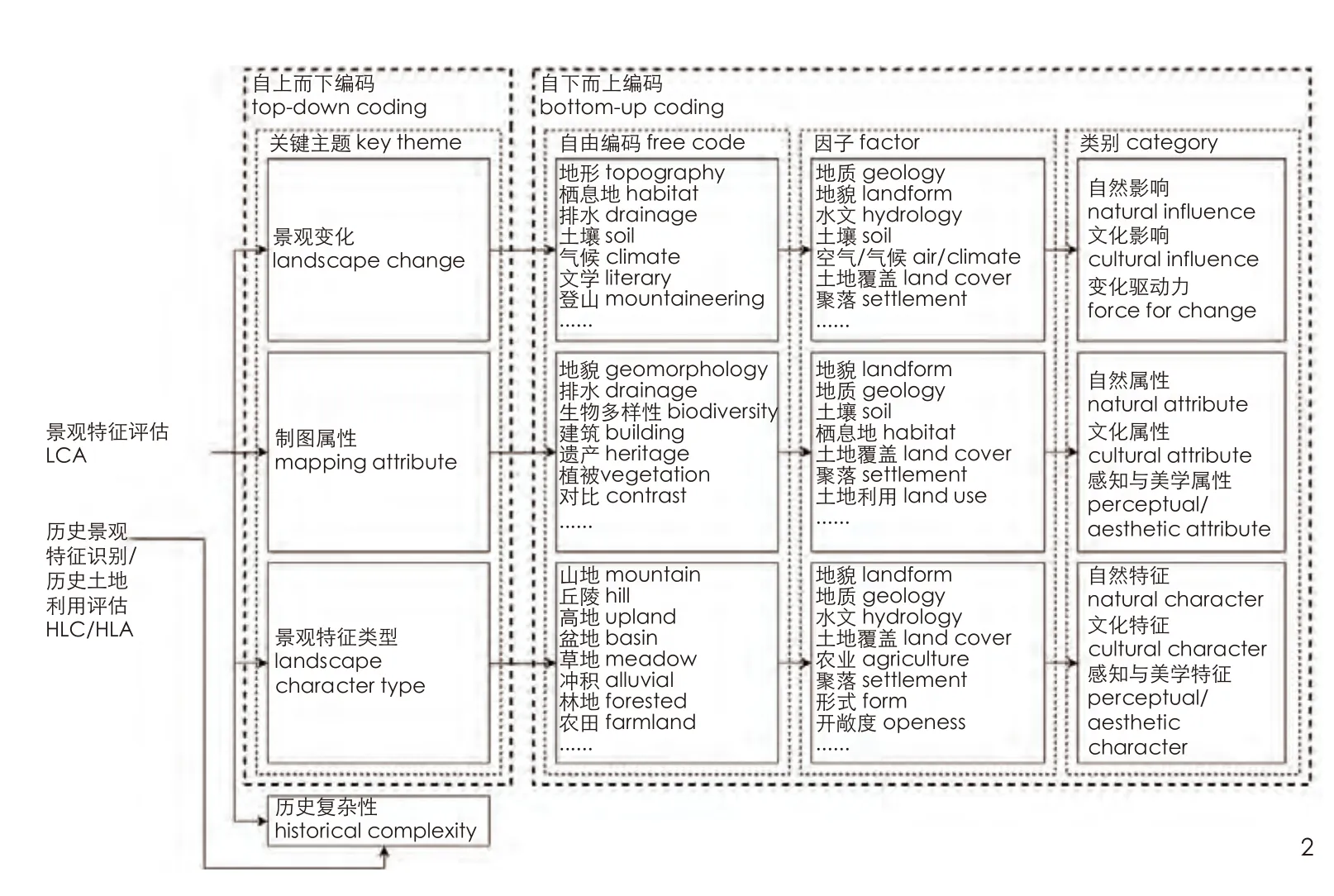
图2 英国国家公园LCA、HLC、HLA文件的分析过程Data analysis process for the LCA, HLC, and HLA documents of the national parks in U.K.
此外,本研究还参照相关的HLC和HLA文件,分析了国家公园LCA文件对历史复杂性的处理方式。不过,由于英国在这方面缺乏统一的评估方法,本研究没有对相关文本信息进行编码,仅提供了定性描述。
2 研究发现
2.1 景观变化
本研究在相关的LCA中共识别出41个因子,其中山地国家公园26个,低地国家公园15个(表2)。按照LCA的内容,这些因子可分为三大类:自然影响、文化影响和变化驱动力(图3)。
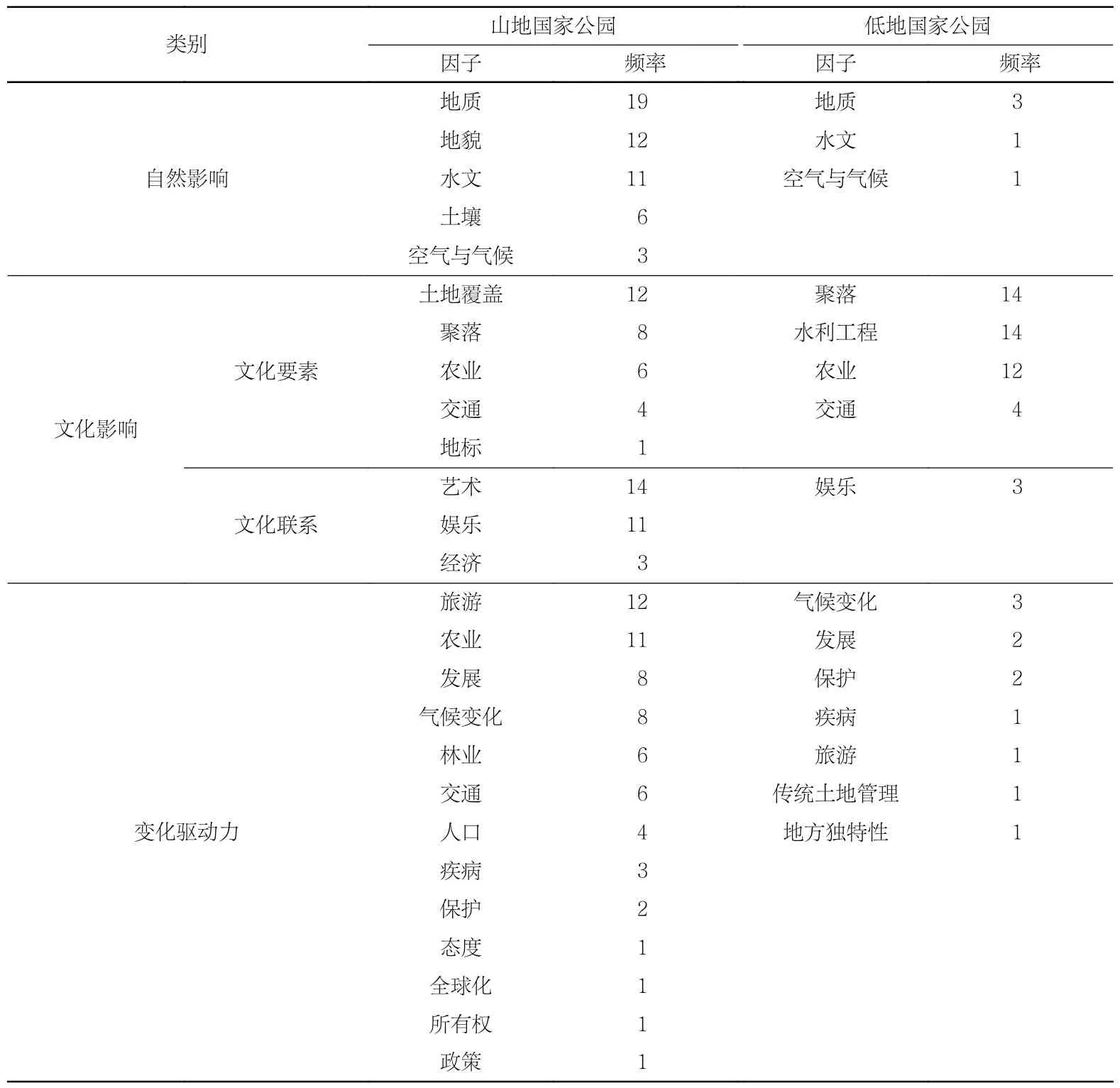
表2 英国15个国家公园LCA中列出的景观变化因子Tab.2 Factors of landscape change listed in the LCAs of 15 U.K.national parks
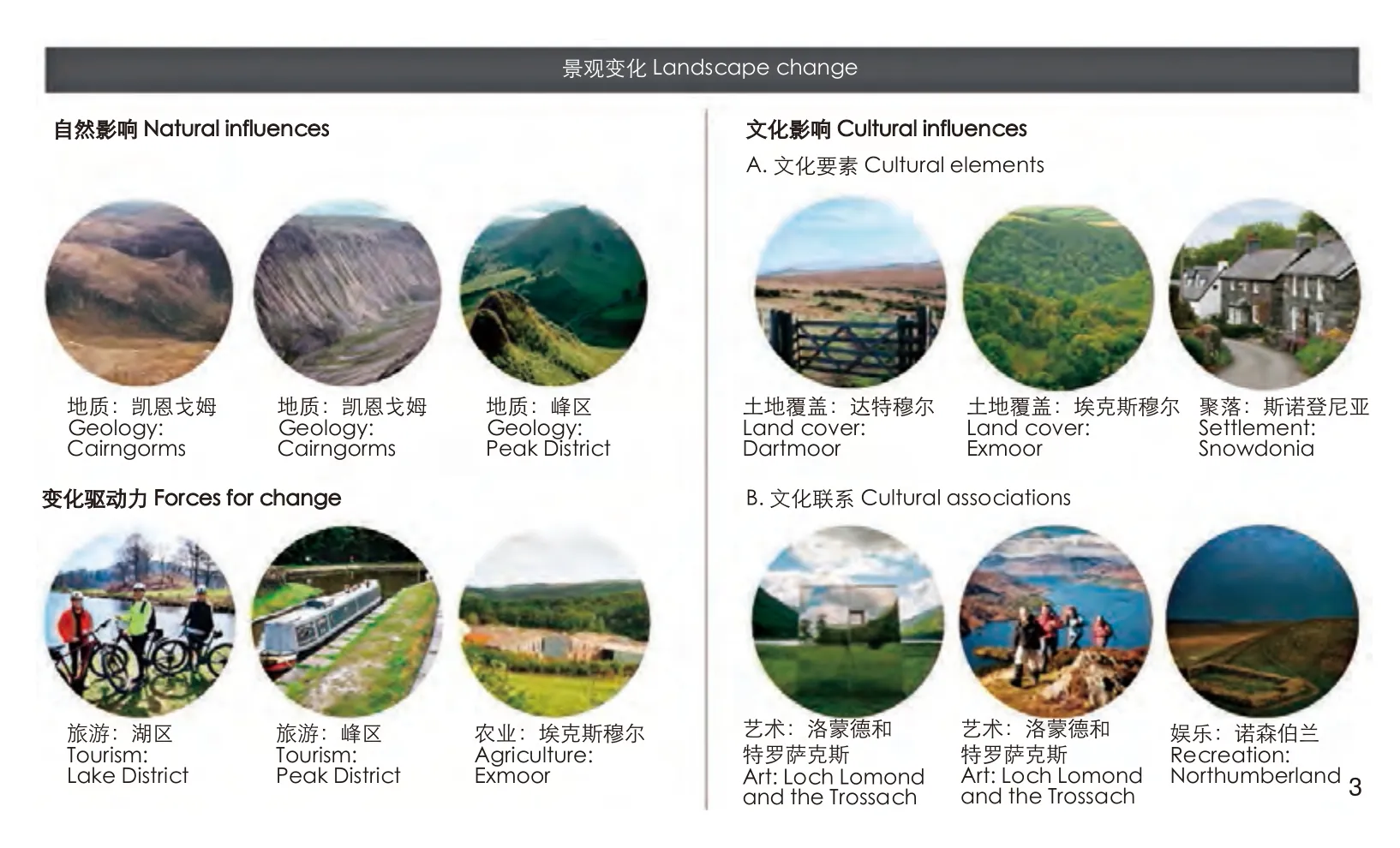
图3 景观变化相关因子的代表性照片Representative photographs of factors associated with landscape change
2.1.1 自然影响
在山地国家公园中,自然影响相关因子的分布频率为:地质19次、地貌12次、水文11次、土壤6次、空气与气候3次。相比之下,低地国家公园呈现出不同的分布情况:地质3次、水文1次、空气与气候1次。就类别而言,山地国家公园LCA比低地国家公园多考虑2个因子,即地貌和土壤。就频率而言,地质在山地和低地国家公园的所有因子中都占有更突出的位置,这表明它在自然因子中具有最重要的景观价值。不过,在自然影响相关因子的排序上,排在第二位的因子存在很大差异:山地国家公园侧重于地貌,而低地国家公园则更关注水文。
2.1.2 文化影响
英国山地和低地国家公园的文化影响相关因子均可分为2个子类别。
第一个子类别是文化要素,指环境中既影响人类文化又受人类文化影响的各个方面。在山地国家公园LCA中,相关因子的出现频率为:土地覆盖12次、聚落8次、农业6次、交通4次、地标1次。而低地国家公园相关因子出现频率的分布情况则有所不同,其中聚落14次、水利工程14次、农业12次、交通4次。相比之下,虽然两者存在3类相同因子,但在其他因子上却有很大差异:山地国家公园增加了土地覆盖,而低地国家公园则增加了水利工程。在出现频率方面,文化影响的主要相关因子排序存在明显差异:山地国家公园较为重视土地覆盖,而低地国家公园则更重视水利工程和聚落。
第二个子类别是文化关联,指的是人们与景观中特定元素之间的联系、关系和意义。在山地国家公园中主要有3种文化关联,包括艺术(14次)、娱乐(11次)和经济(3次)。另外,低地国家公园主要与娱乐有关,共被提及3次。就频率而言,无论是山地国家公园还是低地国家公园,娱乐都是最突出的因子,超过了其他所有因子。
2.1.3 变化驱动力
山地国家公园的景观变化驱动力主要涉及13个因子,包括旅游、农业、发展、气候变化、林业、交通、人口、疾病、保护、态度、全球化、所有权和政策。相比之下,低地国家公园的景观变化驱动力只涉及7个因子,其中与山地国家公园共有的是气候变化、发展、保护、疾病和旅游,此外还有传统土地管理和地方独特性。从出现频率来看,对山地国家公园影响最大的因子是旅游、农业、发展和气候变化,在LCA文件中分别被提及12次、11次、8次和8次。但对于低地国家公园而言,影响较大的因子是气候变化、发展和保护,分别被提及3次、2次和2次。
2.2 制图属性
在15个国家公园的LCA文件中共有21个与制图属性相关的因子,其中山地国家公园占12个,低地国家公园占9个(表3)。这些因子可分为三大类:自然属性、文化属性、感知与审美属性(图4)。

表3 英国15个国家公园LCA中列出的制图属性Tab.3 Mapping attributes listed in the LCAs of 15 U.K.national parks

图4 与制图属性相关的代表性照片Representative photographs associated with mapping attributes
2.2.1 自然属性
绘制山地国家公园的景观特征图涉及5个与自然属性相关的因子,包括地貌、地质、土壤、栖息地和水文。相比之下,除土壤外,低地国家公园的绘图也考虑了类似的一系列自然因子。虽然两者的自然属性相关因子类型相似,但这些因子出现的频率却有显著差异。在山地国家公园中,排在前2位的是地貌和地质,分别被提及10次和9次。在低地国家公园中,地貌与水文并列第一。
2.2.2 文化属性
绘制山地国家公园景观特征图所依据的文化属性相关因子有5个,包括土地覆盖、聚落、土地利用、时间深度和交通。低地国家公园与山地国家公园相比,同样使用土地覆盖、土地利用和聚落3个因子,但缺少另外2个因子。在出现频率方面,两者都将土地覆盖作为首要考虑因子,分别提及15次和2次。然而,在其他因子中,山地国家公园更关注聚落,而低地国家公园更关注土地利用。
2.2.3 感知与审美属性
与感知与审美属性相关的因子是塑造感官和视觉体验不可或缺的组成部分,这些体验基于人们的感受、观点和文化偏好。无论是山地国家公园还是低地国家公园,视觉品质和形式都是主要的感知与审美属性因子,但提及次数有所不同。在山地国家公园LCA中,品质出现了6次,而形式出现了5次,两者相差不大。然而,在低地国家公园LCA中,形式出现了3次,而品质只出现了1次,少于山地国家公园。
2.3 景观特征类型
景观特征类型的名称大多是复合词,如果将这些复合词分解成一系列单词,那么这些单词可以归纳为24个因子。其中,山地国家公园涉及13个因子,低地国家公园涉及11个因子(表4)。为了便于与之前的景观变化和制图属性关联比较,这些因子被进一步分为三大类,即自然特征、文化特征以及感知与审美特征(图5)。
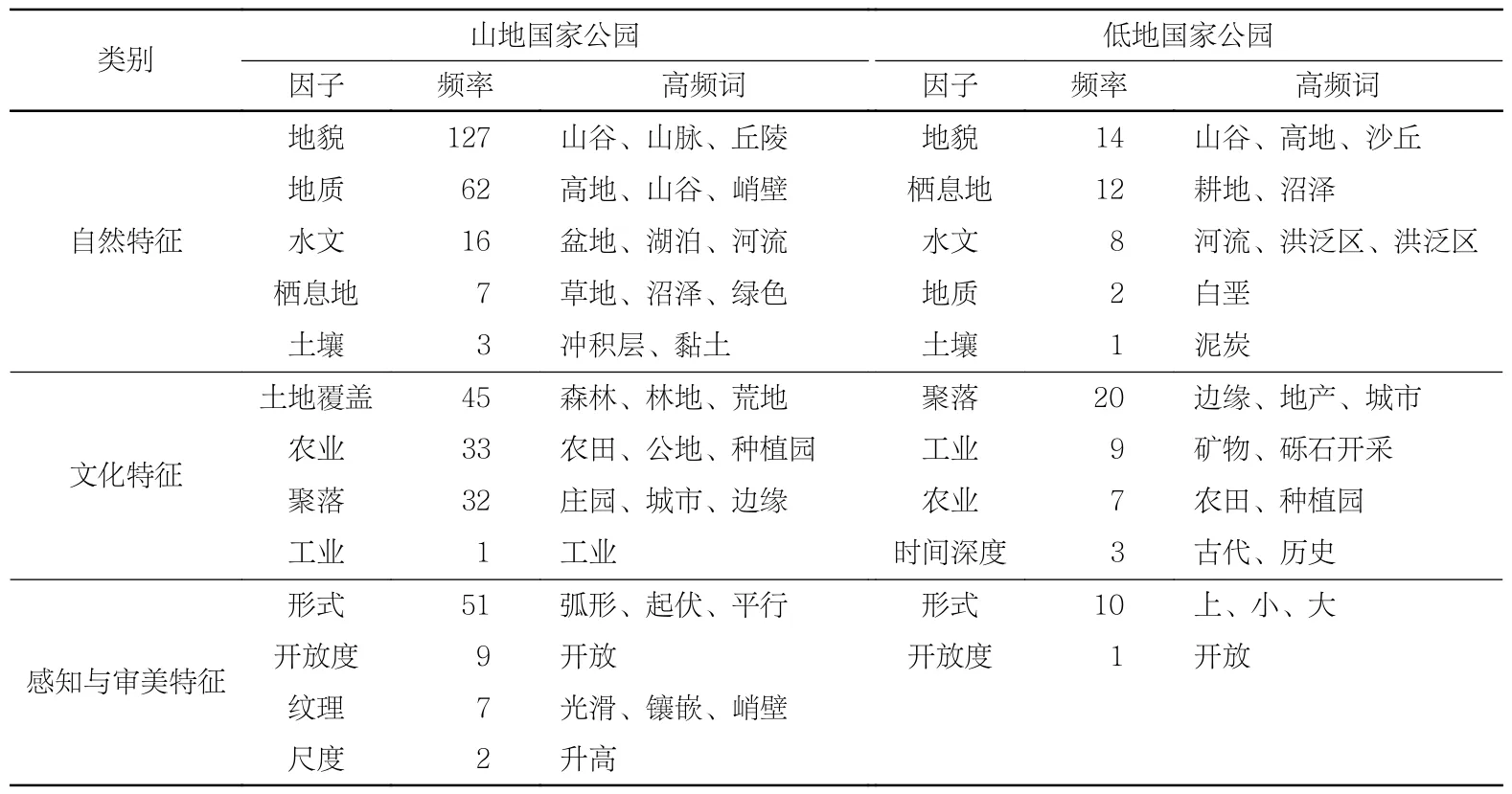
表4 英国15个国家公园LCA中列出的景观特征类型名称用词Tab.4 Words in the names of the landscape character types listed in the LCAs of the 15 U.K.national parks
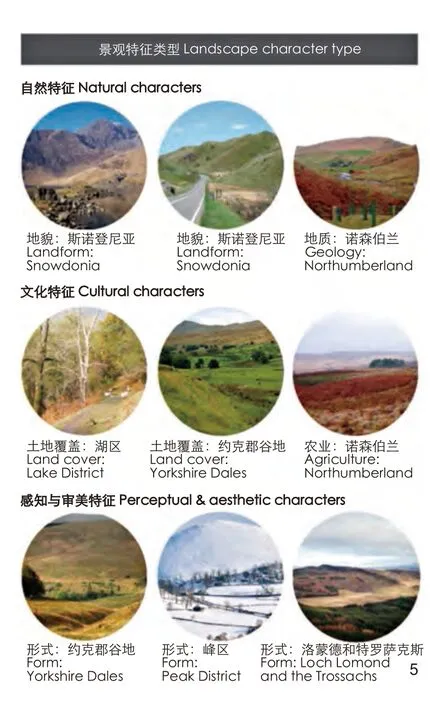
图5 与景观特征类型相关的代表性照片Representative photographs associated with landscape character type
2.3.1 自然特征
在命名景观特征类型时,山地和低地国家公园都包含了与5个自然特征因子有关的词语:地貌、地质、水文、栖息地和土壤。但是,两者在同一因子中使用的词语并不相同。以地貌为例,山地国家公园更多使用“山谷”“山脉”和“丘陵”,而低地国家公园则更多使用“山谷”“高地”和“沙丘”。另一个明显的差异是不同因子出现的频率。在山地国家公园中,自然特征因子的出现频率如下:地貌127次、地质62次、水文16次、栖息地7次、土壤3次。相比之下,低地公园自然特征因子出现频率的分布则有所不同:地貌14次、栖息地12次、水文8次、地质2次、土壤1次。可以看出,两者对地貌、水文和土壤的优先排序相同,但山地国家公园将地质列为第二重要的命名标准,而低地国家公园则将栖息地排在第二位。
2.3.2 文化特征
从类型上看,山地国家公园景观特征类型命名使用的文化特征相关词语可归纳为4个因子:土地覆盖、农业、聚落和工业,其中土地覆盖主要涉及“森林”“林地”和“荒地”等词语。低地国家公园在景观特征类型的命名中也使用了与聚落和工业相关的词语,但缺少与土地覆盖相关的词语。此外,低地国家公园增加了表示时间深度的词语,如“古代”和“历史”。两者的另一个差异体现在文化特征类别的出现频率上:山地国家公园的景观特征类型主要使用与土地覆盖相关的词语来命名,而低地国家公园的景观特征类型则更多地使用与聚落相关的词语来命名。
2.3.3 感知与审美特征
在感知与审美特征方面,山地国家公园景观特征类型的命名主要涉及形式、开放度、纹理和尺度4个因子,而低地国家公园只涉及形式和开放度。虽然两者涉及的感知与审美特征相关因子的类型及数量不同,但都以“形式”作为景观特征类型命名的首要原则,只是在具体的词语选择上有所不同。山地国家公园更常用的与形式相关的词是“弧形”“起伏”和“平行”,而低地国家公园则更多地使用“上”“小”和“大”。
2.4 历史复杂性的处理方式
就历史复杂性的处理方式而言,尽管所有英国国家公园LCA都按照历史分期描述景观变化,但主要以自然属性、现状土地利用和田野形态作为景观特征分类的标准,在景观特征类型命名中很少包含历史信息。只有少数LCA将历史信息纳入景观特征分类,如威尔士LCA将“历史景观”作为制图的一个专题数据集,涉及土地利用、聚落和围合等历史信息。LCA之所以较少将历史信息作为关键因子,是因为LCA通常由在地方政府乡村规划和景观管理团队工作的风景园林师、规划师和地理学家主持。为了弥补LCA过于简化时间深度的缺点,英格兰和苏格兰的大多数国家公园都编制了单独的HLC或HLA。这些评估主要由在地方和国家遗产机构历史环境团队工作的考古学家和历史学家主导,他们并不寻求创建可能与LCA相冲突的景观特征区域,主要是对历史维度进行补充。然而,由于LCA与HLC或HLA使用的数据和分析方法不同,它们还没有真正融合在一起。
就HLC和HLA的具体内容而言,不同地区的国家公园管理者对历史景观信息的选择也不尽相同。HLC强调对文化景观的各个方面进行整体评估,根据土地利用、形成时间和空间模式确定历史景观特征类型和区域(如峰区国家公园、湖区国家公园)。HLA侧重于土地利用,既包括工业化生产等现代土地类型,也包括史前农业等过去的土地类型。这种差异也可能受到不同地区历史景观数据可用性的影响。
3 讨论
3.1 山地与低地国家公园景观特征描述的差异
将上述研究结果放在一起进行比较,可以发现山地与低地国家公园之间存在一些明显的差异。一方面,山地国家公园LCA共涉及51个因子,远远多于低地国家公园的36个。同样的,在景观变化、制图属性和景观特征类型的每个部分中,山地国家公园所涉及的因子也多于低地国家公园。在山地国家公园LCA中考虑更多因子的原因可能是山地地形条件复杂,导致人类与自然互动的方式更加多样。另一方面,上述因子在山地和低地国家公园LCA中出现的频率也存在差异。总体而言,山地国家公园LCA在自然相关因子中更侧重地质、地貌和土壤,在文化相关因子中强调土地覆盖、艺术和娱乐,在感知与审美相关因子中侧重形式。这些因子之间有着明显的相互联系,其中山地景观的地质和地貌复杂性是决定性因子,这一方面导致出现多样化的土壤条件和土地覆盖类型,另一方面导致出现丰富的空间形式和质量,从而对艺术、娱乐、旅游等活动具有强大的吸引力。
山地国家公园和低地国家公园在处理历史复杂性的方法上没有显著差异,具体方法根据国家公园所在地区的不同而有所区别。大多数国家公园都有与LCA分离的HLC或HLA,其优点是有足够的时间深度,但缺点是不能与LCA无缝集成。少数国家公园将历史景观作为制图属性之一,其优点是可以与LCA充分融合,但缺点是不可避免地需要简化历史复杂性,使历史信息不至于显得过于冗长。这2种方法都有助于理解时间深度,但它们各自的缺点意味着将历史复杂性整合到景观表征中仍然是一项正在进行的工作。虽然历史复杂性尚未完全融入LCA中,但我们有理由相信可以通过协同合作来缩小LCA与HLC或HLA之间的隔阂,从而导向一种能够涵盖自然和文化等各个方面对景观的更全面的理解。
3.2 英国国家公园景观特征描述方法的可移植性
英国国家公园LCA模式可以进行调整并应用于具有类似山地国家公园的其他国家和地区,其中关于自然、文化、感知与审美的核心概念,以及所采用的数据收集、分析和利益相关者参与等方法,均可以为这些国家和地区的LCA提供基础框架。然而,为了确保该模式在不同情况下的有效性,相关国家和地区可能需要根据独特的环境和文化背景进行某些调整和改进,否则很难适应不同的生态系统过程、土地利用模式和文化规范。这种因地制宜的调整和改进应该重点关注3个方面的差异:1)不同地理区域的山脉环境条件存在差异,内在特征受到气候、海拔和坡度的共同影响;2)不同山地区域的文脉背景差异较大,历史沿革和社会结构的差异导致土地利用趋势不同;3)不同山地区域的利益相关者对景观的认知存在差异,从而出现了关于景观结构和价值的多样化意见。对于这些潜在差异的回应应该体现在LCA的整体框架中,特别是要具体化到与景观变化、绘图属性、景观特征类型、历史复杂性处理方式相关的内容中。
4 结论
本研究对英国12个山地国家公园和3个低地国家公园的LCA进行了比较,解读了山地文化景观的自然和文化元素之间错综复杂的相互作用关系。这些山地文化景观以独特的方式融合了地质构造、生态系统以及历史上人类活动的痕迹,其中人类活动改变了自然环境的特征。本研究对相关国家公园的LCA文件开展内容分析,对景观变化、制图属性和景观特征类型3个部分的内容进行编码,识别了关键信息的类别和频率,发现山地国家公园LCA所考虑的因子不仅在总数上多于低地国家公园,而且各部分的数量均较多。在这些因子的出现频率上,山地国家公园也与低地国家公园存在差异。本研究还结合相关HLC和HLA文件,分析了英国国家公园LCA处理历史复杂性的方式,发现处理方式主要因所在地区行政管理体制的不同而有所差异,在同一行政区划范围内则并没有显著差异。
本研究表明,自然地形条件可以对LCA产生重大影响。尽管英国各个国家公园的LCA都采用类似的研究框架和技术路线,但山地国家公园的LCA仍然与低地国家公园的LCA不同。这种差异不仅体现在景观变化影响因素的类型和优先级上,还体现在制图属性的类型和优先级上,以及景观特征类型命名的具体细节上。上述发现不仅增进了对英国国家公园LCA模式的了解,而且还为如何描述全球范围内其他山地国家公园的文化景观特征提供了宝贵的启示。本研究存在2点局限性。首先,本研究主要依赖于LCA、HLC和HLA等公开文件,而没有分析与这些文件的编制背景、过程、关键参与者相关的其他文献,因此可能忽略了影响文件内容的重要因素。其次,研究侧重分析LCA文件,对HLC和HLA文件仅进行了初步分析。然而,HLC和HLA都有自己独特的学科传统和研究范式,具有重要的研究价值。未来的研究可以针对这些不足,全面解读英国国家公园的LCA模式,从而更好地为具有相似山地景观的国家和地区提供参考。
图表来源:
文中图表均由作者绘制。其中图1高程数据来源于Edinburgh DataShare网站(datashare.ed.ac.uk),英格兰国家公园边界来源于自然英格兰(www.data.gov.uk),苏格兰国家公园边界来源于苏格兰政府地理信息科学与分析团队(hub.arcgis.com),威尔士国家公园边界来源于威尔士自然资源局(datamap.gov.wales);图3、4中的照片来源于表1中相应的LCA文件及国家公园网站;图5中的照片来自表1中相应的LCA文件。
(编辑 / 边紫琳)
作者简介:
(马来西亚)陈巧遴 / 女 / 北京林业大学园林学院在读硕士研究生 / 研究方向为风景园林规划与设计
李正 / 男 / 博士 / 北京林业大学园林学院副教授 / 本刊青年编委 / 研究方向为城市山地景观保护与利用
通信作者邮箱:zhengli1984@bjfu.edu.cn
TAN Y X, LI Z.Characterizing Mountain Landscape Complexity: Comparison of Landscape Character Assessment in the National Parks of the United Kingdom[J].Landscape Architecture, 2024, 31(1): 39-55.DOI: 10.3724/j.fjyl.202309040392.
Characterizing Mountain Landscape Complexity: Comparison of Landscape Character Assessment in the National Parks of the United Kingdom
(MYS) Yeng Xuan Tan, LI Zheng*
Abstract:[Objective] Landscape characterisation aims at categorizing and describing areas with similar patterns of element combination, simplifying infinite landscape complexity into manageable spatial units.Existing relevant literature tends to explore concepts and frameworks applicable to all landscapes,focusing on how to enhance process transparency and incorporating historical complexity within universal technical routes, and has yet to be differentiated according to different landform types.This paper seeks to clarify whether mountain landscape characterisation different from that of lowlands and identify ways of interpreting the complexity of cultural landscapes in mountainous areas.The findings will contribute to a deeper understanding of the complex relationships between natural and cultural elements in mountain cultural landscapes, as well as to a more targeted approach to future management.[Methods] This study focuses on collecting documents related to landscape characterization of 15 national parks, including 20 landscape character assessments (LCA), 10 historic landscape characterisations (HLC), and 2 historic land-use assessments (HLA).For the LCA documents, this study adopts a content analysis method to categorizing and analyzing recurring the type and frequency based on NVivo software.Two coding approaches are adopted and integrated.This study also analyzes the treatment of historical complexity in the LCA documents of the national parks with reference to the relevant HLC and HLA documents, but without coding due to the lack of a consistent assessment methodology across U.K.in this aspect.[Results] In terms of landscape change, a total of 41 factors were identified in the relevant LCAs, which can be grouped into 3 broad categories, including natural influence, cultural influence, and force for change.A total of 21 mapping attribute related factors were identified and grouped into 3 categories, including natural attribute, cultural attribute, and perceptual and aesthetic attribute.The compound names of landscape character types are broken down into a series of words, which are grouped into 24 factors that fall into 3 categories, including as natural character, cultural character, and perceptual and aesthetic character.As far as the treatment of historical complexity is concerned, although all U.K.National Parks LCAs describe landscape changes according to historical phasing, they mainly use natural attributes, current land use and field morphology as the criteria for landscape character categorization, and they seldom include temporal information in the naming of landscape character types.Only a few LCAs incorporate historical information into landscape character classification, such as the Wales LCAs.To compensate for the disadvantage of over-simplifying the temporal depth of LCA, many national parks in England and Scotland create separate HLCs or HLAs, led by archaeologists and historians.This study reveals variations between mountain and lowland national parks.The approach to historical complexity in different national parks is primarily influenced by the administrative system of the region in which they are located, rather than the type of park.Natural topographic conditions can have a significant impact on landscape character assessment,even though similar research frameworks and technical routes may be used for landscape character assessment in mountains and lowlands.[Conclusion] The findings enhance understanding of U.K.National Park assessment models, and offer insights for characterizing cultural landscapes in mountainous national parks globally.The study provides a foundation for future research to comprehensively interpret the landscape characterisation models in U.K.national parks and guide similar regions with mountainous landscapes.
Keywords:cultural landscape; characterisation; mountain; complexity; national park
©BeijingLandscape ArchitectureJournal Periodical Office Co., Ltd.Published byLandscape ArchitectureJournal.This is an open access article under the CC BY-NC-ND license.
In academia, the landscape affected by human activity has been described in many ways,and a prefix that often accompanies the word“landscape” is “cultural.” Cultural landscape studies are increasingly polyphonic: prior to 1950,the term landscape was used only by the geography and landscape architecture professions, but between 1950 and 1990 a variety of scholars working on socio-cultural issues began to see landscape as an important piece of evidence for studying the ways in which human communities operate[1].In essence, cultural landscape is a dynamic and evolving concept that encompasses both tangible and intangible aspects of a place,such as landform, geology, human-modified ecosystems such as hydrology and vegetation,traditions, language, and social practices[2].Cultural landscape study is thus a process of exploration and discovery that reveals the intricate connections between people, place, and time[3].To effectively manage landscape change for sustainable development, the first issue to be addressed is how to characterize cultural landscape complexity.Landscape characterization, which originated in the United Kingdom in the 1980s, is just such a landscape classification and assessment tool, and in recent years it has been gradually introduced to other countries around the world, including China,to provide a holistic research framework and a basis for decision-making in managing landscape change[4].Landscape character is the holistic pattern of combinations of elements that make one landscape different from another, and assessment aims to categorize and describe areas with similar characteristics[5].Key to landscape character assessment is landscape typology, the use of explicit rules and repeatable procedures to draw boundaries in a largely continuous landscape,reducing the almost infinite variability to relatively homogeneous spatial units suitable for management[6].Landscape character assessment distinguishes between landscape character types,which are spatial units with broadly similar combinations of geology, topography, drainage patterns, vegetation, land use, etc., and landscape character areas, which are spatial units with specific patterns of landscape character type combinations.Currently, the mainstream technology relies heavily on maps for information input and output,integrating remote sensing images and map data based on the GIS platform, representing landscape character types and areas with polygons, and describing the basis of delineation, key features,driving forces, and other information through polygon attribute tables[7].
The existing literature focuses on two issues.Firstly, it addresses the challenge of mitigating researcher subjectivity, as any exploration of landscape characterization inherently grapples with the broader query of “what constitutes a landscape,”a query often shaped by the very process of assessment[8].To bridge the divide between natural and human sciences, certain scholars have advocated for a division of landscape characterization into two distinct components: a neutral landscape characterization and a landscape assessment that incorporates value judgments[9],and further dismantling of landscape characterization into a few steps in a sequential order of natural, cultural, and visual dimensions[10].This exploration based on step-by-step procedures aims to enhance process transparency rather than pursuing standardization and objectification[11].Another issue is how to reveal the changing nature of landscapes, with current landscape character assessments tending to simplify historical complexity by examining the timing and drivers of the formation of extant visible heritage features based only on time depth, such as the historic landscape characterisation (HLC) in the U.K.[12].In response, some “landscape biography” scholars have called for an understanding of landscapes from the perspective of authorship[13], analysing landscape change based on temporal slices[14-15],although relevant research still lacks spatial breadth to match landscape character assessment[16].
In general, the above studies tend to explore concepts and frameworks applicable to all landscapes, focusing on how to enhance process transparency and incorporating historical complexity within universal technical routes, and has yet to be differentiated according to different landform types.However, topographical attributes play a crucial role in comprehending the origin and present condition of cultural landscapes, and human interactions vary depending on the specific topographic characteristics of the land.Among various landform types, mountains account for a quarter of the Earth’s land surface area, and they impose more constraints on human production and life compared to lowlands, making the assessment of their landscape characteristics more urgent and necessary.Relevant studies by some scholars in recent years have addressed mountains,but often only as a component of a larger administrative division or region[17-20]or analyzed them in conceptual frameworks such as cultural and landscape heritage or nature conservation sites[21-22].Overall, there is still a lack of landscape characterization studies on the special conditions of mountains, and comparative studies under the perspective of topography and geomorphology are even rarer.
To fill in the gap, this paper compares 12 mountain national parks and 3 lowland national parks in the U.K., seeking to clarify whether mountain landscape characterisation different from that of lowlands.The U.K.national parks have been chosen for the case study for two reasons.One reason is that most of these national parks are in mountainous areas, while a few are also located in plains, which provides favorable conditions for comparative studies.Another reason is that the United Kingdom is one of the leading producers of landscape characterisation research and has been carrying out nationwide multi-scale assessments since the 1980s.Due to the political system in the U.K., there are local variations in the specific models of these assessments: in England, the model includes landscape character assessment(LCA) and historic landscape characterization;Scotland’s model incorporates LCA and historic land-use assessment (HLA); in Wales, the LCA is used as the primary model.Northern Ireland is excluded from this study because it does not have any national parks within its territory[23].LCA comprises various levels, including national,county, and district, while HLC focuses on the county and district levels.By comparing the landscape characterisation methods of different U.K.national parks, we can expect to identify ways of interpreting the complexity of cultural landscapes in mountainous areas.The findings will contribute to a deeper understanding of the complex relationships between natural and cultural elements in mountain cultural landscapes, as well as to a more targeted approach to future management.
1 Methodology
1.1 Study Area
There are currently 15 national parks in the U.K.: 10 in England, 2 in Scotland, and 3 in Wales(Fig.1).Topographically, 12 of these national parks are dominated by mountainous landscape features,including Cairngorms National Park, Loch Lomond and the Trossachs National Park,Northumberland National Park, Lake District National Park, North York Moors National Park,Yorkshire Dales National Park, Peak District National Park, Snowdonia National Park, Brecon Beacons National Park, Exmoor National Park,South Downs National Park, and Dartmoor National Park.Most of these mountain national parks are in the north, west and south of the British Isles, and are generally higher in elevation in the north and lower in the south, with the highest being the Cairngorms, located in Scotland.The remaining 3 national parks are characterized as lowland: The Broads is renowned for its extensive network of rivers, lakes, and marshes; the New Forest contains wetland habitats such as bogs,mires, and waterlogged areas; and the Pembrokeshire Coast encompasses a stunning coastline and some wetland areas.In this study, the mountain national parks are targeted as the main subjects and, to better identify the specificity of their landscape characterization, the lowland national parks were also included for comparison.
1.2 Data Acquisition
This study focuses on collecting documents related to landscape characterization of 15 national parks, with data mainly from the official websites of relevant park authorities, local governments, and national organizations.As of August 31, 2023, the authors found a total of 32 documents, including 20 LCAs, 10 HLCs, and 2 HLAs (Tab.1).All the national parks have individually produced their LCA’s, but there are differences in specifics.Some have revised their LCAs, the most recent version was then selected for analysis in this study (e.g.,Northumberland National Park).If the latest version did not contain complete content, then the previous version was referenced along with it (e.g.,North York Moors National Park).In addition,some LCAs only address landscape character areas,whereas information related to landscape character types is included in national LCAs, and for this reason the latter were included in the analysis in this study (e.g., Cairngorms National Park,Snowdonia National Park).In comparison, there are greater differences in the preparation of HLC and HLA.Of the national parks in England,4 (Northumberland National Park, Lake District National Park, Peak District National Park,Exmoor National Park) have produced separate HLCs, 5 (North York Moors National Park,Yorkshire Dales National Park, South Downs National Park, Dartmoor National Park, New Forest National Park) have had their historic landscape character assessed by the local governments as part of the counties or cities in which they are located, and the last remaining one(The Broads National Park) is temporarily unavailable for information on its website.Besides,the national parks in Scotland both have produced separate HLAs, while none of the national park in Wales have undertaken HLC or HLA.In view of the differences in the way historic landscape characterisation has been carried out, this study takes LCA documents, which are available in all 15 national parks, as the main objects of analysis.
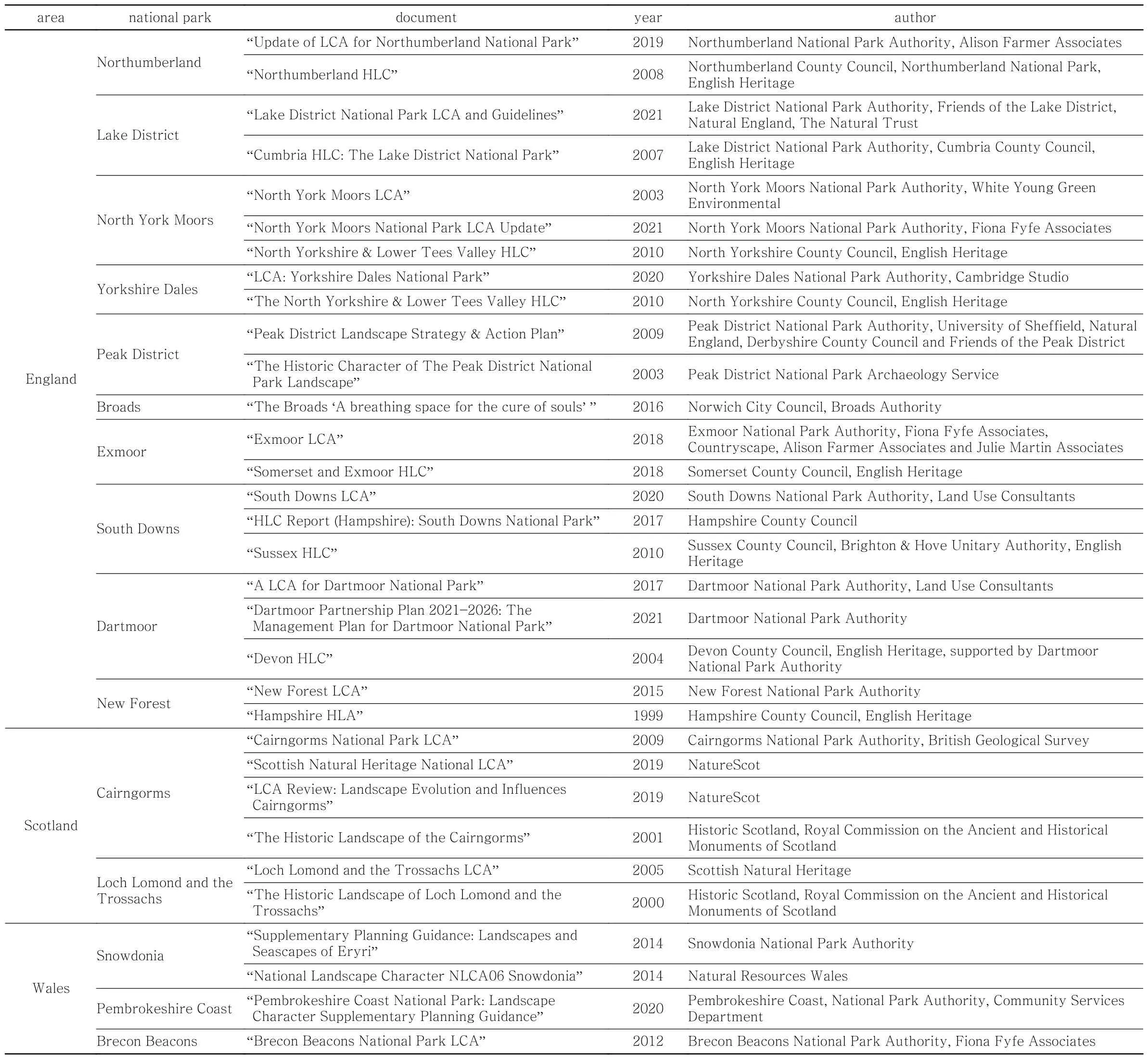
Tab.1 The LCA, HLC, and HLA documents of the U.K.national parks used by this study
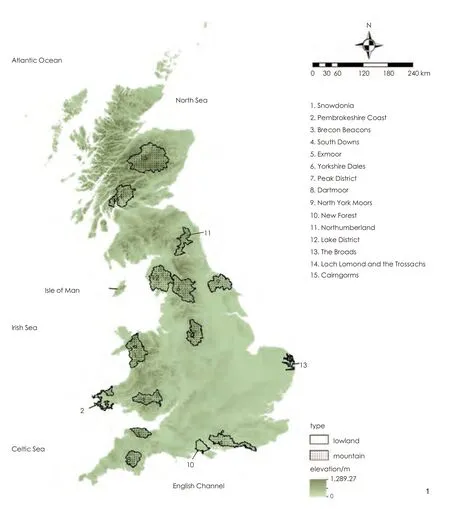
图1 Location of 15 national parks in U.K.
1.3 Data Analysis
LCA generally contains two parts: a descriptive part that characterizes the historical evolution and present-day conditions of a landscape in a relatively neutral manner, and a value-judgment part that develops evaluation criteria based on different management objectives.Because different national parks differ in their management goals and have different criteria for value judgments, only the more comparable LCA descriptive components were analyzed in this study.For the LCA documents, this study adopts a content analysis method to categorizing and analyzing recurring the type and frequency based on NVivo software.By establish relationships between codes, connections or associations between different themes can be captured.Two coding approaches are adopted and integrated: the top-down approach pre-determines key themes based primarily on the chapter structure of the LCA documents, while the bottom-up approachidentifies information related to the key themes during the process of reading the specific content of the LCA text, maximizing the retention of details in the original text through free coding.The entire coding process comprises four steps: 1) Presetting three key themes, including landscape change, mapping attribute, and landscape character type; 2) Conducting free coding of the LCA documents; 3) Grouping the free codes into factors; 4) Categorizing the factors into high-level categories (Fig.2).
In addition, this study analyzed the treatment of historical complexity in the LCA documents of the national parks with reference to the relevant HLC and HLA documents.However, due to the lack of a consistent assessment methodology across the U.K.in this aspect, this study did not code the relevant textual information and only provided qualitative descriptions.
2 Findings
2.1 Landscape Change
A total of 41 factors were identified in the relevant LCAs, of which mountain national parks accounted for 26 and lowland national parks for 15(Tab.2).Following the content structure of the LCAs, these factors can be grouped into three broad categories, including natural influences,cultural influences, and forces for change (Fig.3).
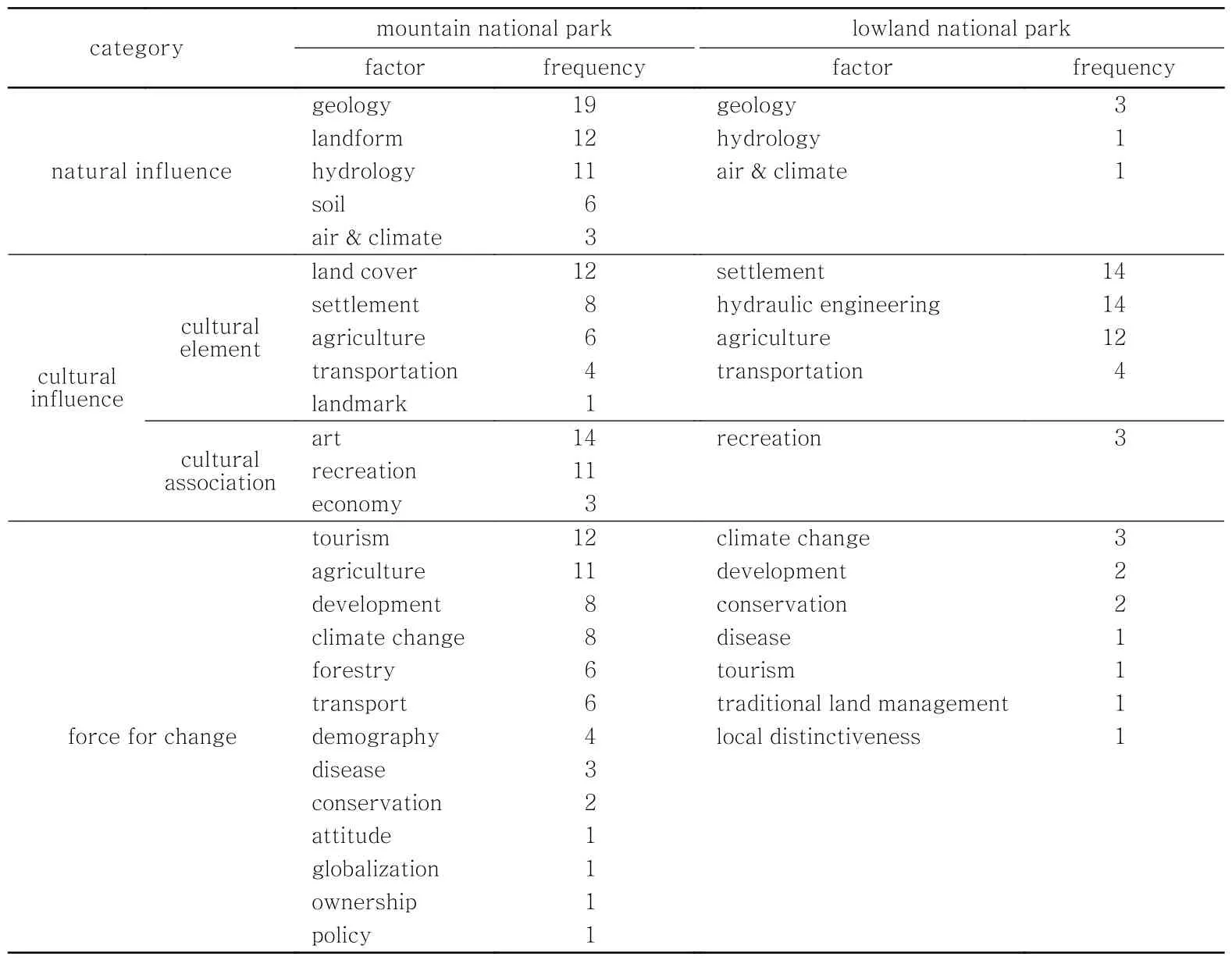
Tab.2 Factors of landscape change listed in the LCAs of 15 U.K.national parks
2.1.1 Natural Influence
In the mountain national park, the natural influence related factors are distributed in the following frequencies: 19 for geology, 12 for landform, 11 for hydrology, 6 for soils, and 3 for air and climate.In contrast, lowland national parks exhibit the following different distribution: 3 for geology, 1 for hydrology, and 1 for air and climate.In terms of category, the mountain national park LCAs consider three more factors than the lowland national parks, namely landform and soils.In terms of frequency, geology is more prominently represented compared to all the factors in both mountain and lowland national parks, suggesting that it holds a most significant landscape value within the realm of natural factors.However, there is considerable difference in the ranking of the second natural influence related factor: mountain national parks focus on landform, while lowland national parks pay more attention to hydrology.
2.1.2 Cultural Influence
The cultural influence related factors of mountain and lowland national parks in the United Kingdom can be divided into two sub-categories.The first sub-category is cultural element, which refers to various aspects of environment that both influence and are influenced by human culture.The frequency distribution of relevant factors in the LCAs of the mountain national parks is as follows:12 for land cover, 8 for settlements, 6 for agriculture, 4 for transportation, and 1 for landmarks.The frequency of occurrence of the relevant factors in the lowland national parks is different, with 14 for settlements, 12 for agriculture, 4 for transportation, and 14 for hydraulic engineering.In comparison, while the two are identical in the three categories of factors,they are quite different in the other factors: the mountain national parks add ground cover, while the lowland national parks add hydraulic engineering.In terms of frequency of occurrence,there is a significant contrast in how the primary cultural influence related factors are ranked: the mountain national parks give considerable importance to land cover, while the lowland national parks give more weight to hydraulic engineering and settlements.
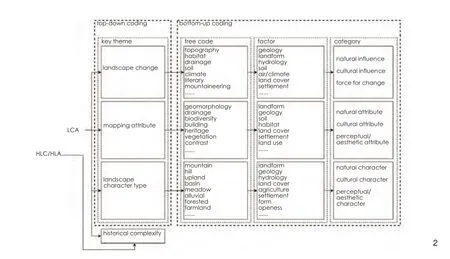
图2 Data analysis process for the LCA, HLC, and HLA documents of the national parks in U.K.
The second sub-category is cultural association, which refers to the connections,relationships, and meanings that people attach to specific elements of the landscape.In the mountain national parks, there are mainly 3 cultural associations, including 14 for art, 11 for recreation,and 3 for economy.On the other hand, the lowland national parks are primarily concerned with recreation, which is mentioned 3 times.When it comes to frequency, recreation is the most prominent factor in both mountain and lowland national parks, surpassing all the other factors.

图3 Representative photographs of factors associated with landscape change
2.1.3 Force for Change
The forces for change in the mountain national parks involve 13 main factors, including tourism, agriculture, development, climate change,forestry, transport, demography, disease,conservation, attitude, globalization, ownership,and policy.In comparison, the forces for change in the lowland national parks involve only 7 factors,of which climate change, development,conservation, disease and tourism are common to the mountain national parks, in addition to traditional land management and local uniqueness.In terms of frequency of occurrence, the most influential forces for the mountain national parks are tourism, agriculture, development, and climate change, which are mentioned 12, 11, 8, and 8 times, respectively, in the LCAs.But for the lowland national parks, the more influential forces are climate change, development, and conservation, which are mentioned 3, 2, and 2 times respectively.
2.2 Mapping Attributes
There is a total of 21 factors associated with mapping attributes in the LCA documents for the 15 national parks, of which 12 were for mountain parks and 9 for lowland national parks (Tab.3).These factors can be grouped into 3 main categories, including natural attribute, cultural attribute, and perceptual and aesthetic attribute(Fig.4).
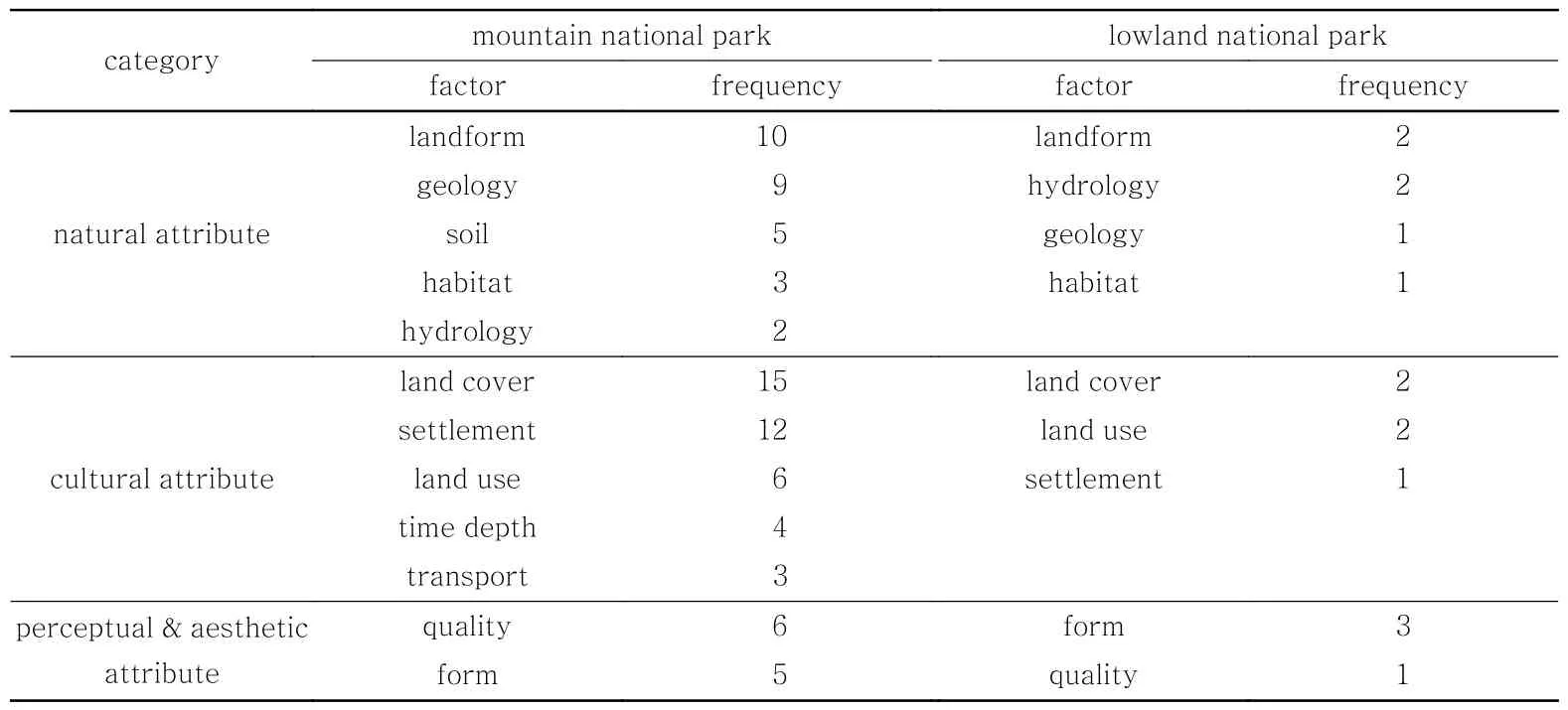
Tab.3 Mapping attributes listed in the LCAs of 15 U.K.national parks
2.2.1 Natural Attribute
Mapping the landscape character of the mountain national parks involves five natural attribute related factors, including landform,geology, soil, habitat, and hydrology.In comparison, the mapping of the lowland national parks also considers a similar set of natural factors,except for soil.While the two are similar in terms of the types of natural attribute related factors,there are significant differences in the frequency of occurrence of these factors.For the mountain national parks, the top two are landform and geology, mentioned 10 and 9 times, respectively.Landform and hydrology are tied for first place in frequency of occurrence in the lowland national park.
2.2.2 Cultural Attribute
There are five factors related to cultural attributes on which landscape character mapping of the mountain national parks is based, including land cover, settlement, land use, time depth, and transport.The lowland national parks share 3 factors with the mountain national parks, namely land cover, land use and settlement, but lack the other two factors.In terms of frequency of occurrence, both have land cover as the first factor to be considered, with 15 and 2 mentions respectively.However, among the other factors,the mountain national parks pay more attention to settlements, while the lowland national parks pay more attention to land use.
2.2.3 Perceptual and Aesthetic Attribute
Perceptual and aesthetic attribute related factors are integral components that shape the sensory and visual experiences based on their feelings, views, and cultural preferences.Both mountain and lowland national parks have visual quality and form as the major perceptual and aesthetic factors, but there are differences in the number of mentions.In the mountain national park LCAs, quality appears six times, while form appears five times, which is not very different.However, in the lowland national park LCAs, form occurs 3 times while quality occurs only 1 time,much less than the former.
2.3 Landscape Character Type
Most of the names of landscape character types are compounds, and if these compounds are broken down into a series of words, then these words can be grouped into 24 factors.Of these,13 factors are involved in the mountain national parks, while 11 factors are involved in the lowland national parks (Tab.4).To facilitate correlative comparisons with the previous landscape change and mapping attributes, these factors were further grouped into three broad categories, namely natural characters, cultural characters, and perceptual and aesthetic characters (Fig.5).
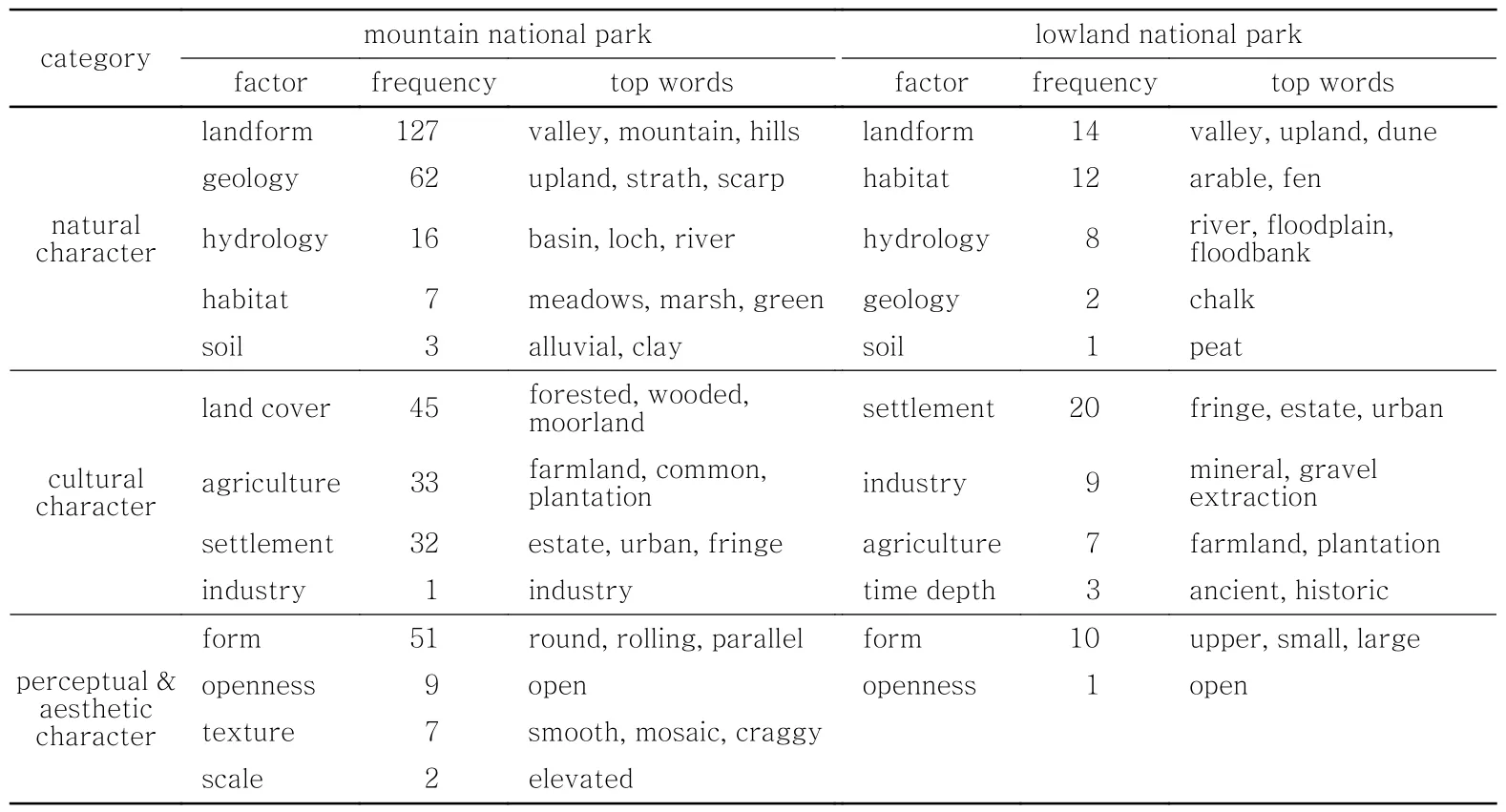
Tab.4 Words in the names of the landscape character types listed in the LCAs of the 15 U.K.national parks

图4 Representative photographs associated with mapping attributes
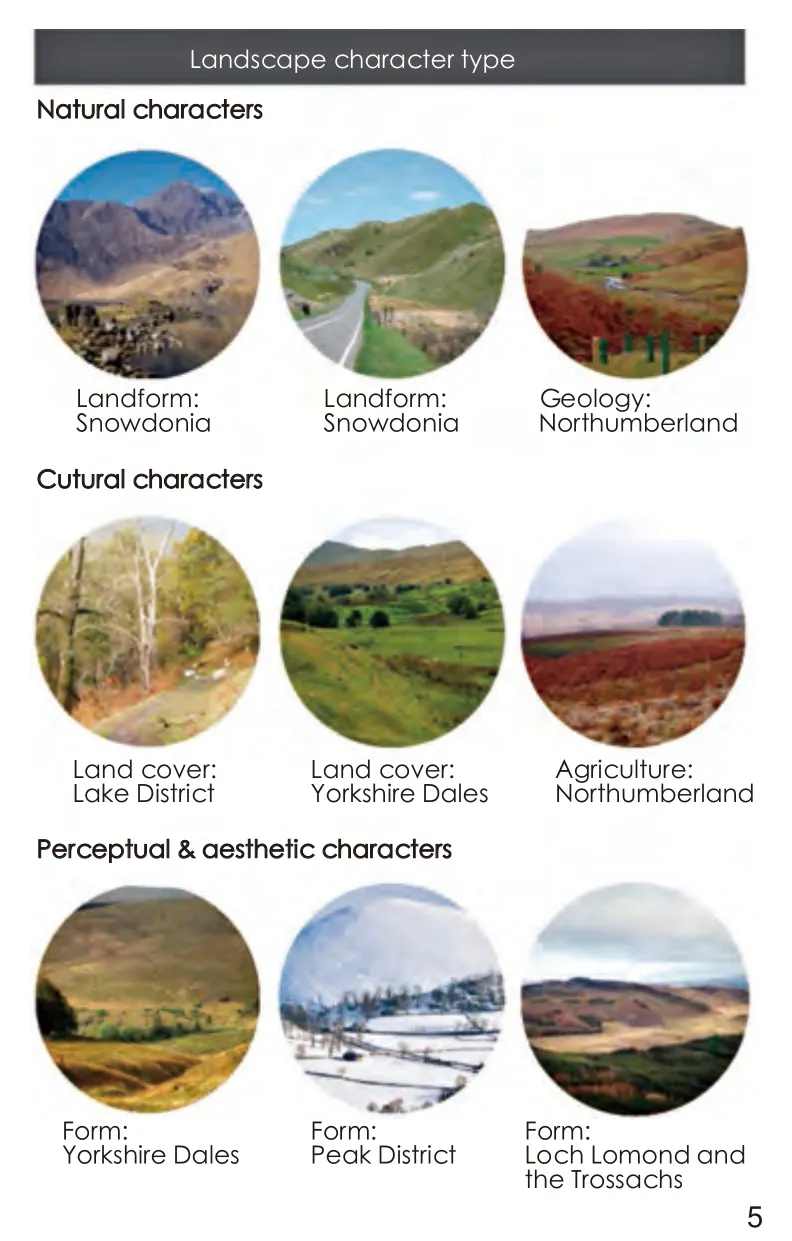
图5 Representative photographs associated with landscape character type
2.3.1 Natural Character
Both the mountain and lowland national parks include words related to five natural character related factors in naming landscape character types: landform, geology, hydrology,habitat, and soil.However, the two do not use the same words within the same factors.In the case of landform, for example, the mountain National Parks more often use “valley,” “mountain” and“hill,” while the lowland national parks are more likely to use “valley,” “upland” and “dune.”Another noticeable difference is in the frequency of occurrence of different factors.In the mountainous park, the natural character factors are distributed with the following frequencies: 127 for landform, 62 for geology, 16 for hydrology, 7 for habitats, and 3 for soils.In contrast, the distribution of the frequency of occurrence of the natural character related factors in the lowland parks is different: 14 for landform, 12 for habitats,8 for hydrology, 2 for geology, and 1 for soils.It can be noted that both ranked the same priority for landform, hydrology, and soils, but the mountainnational parks ranked geology as the second most important naming criterion, while the lowland national parks placed habitat in second place.
2.3.2 Cultural Character
Typologically, the cultural character related words used in naming landscape character types in the mountain national parks can be grouped into four factors: land cover, agriculture, settlement,and industry.Of these, land cover mainly relates to words like “forested,” “wooded,” and “moorland.”The lowland national parks also use words related to settlement and industry in the naming of landscape character types, but lack words related to land cover.In addition, the lowland national parks have added words that indicate time depth, such as“ancient” and “historic.” Another difference between the two is reflected in the frequency of occurrence of cultural characteristic categories: The landscape character types of the mountain national park are named primarily using land cover-related words, while those of the lowland national park are named more often using settlement-related words.
2.3.3 Perceptual and Aesthetic Character
In terms of perceptual and aesthetic character, the naming of landscape character types for the mountain national parks mainly involves four factors, including form, openness, texture, and scale.The lowland national parks only involve form and openness.Although they differ in the number of types of perceptual and aesthetic character related factors involved, both use form as the overriding principle in the naming of landscape character types, differing only in their specific choice of words.The more commonly used formrelated words in the mountain national parks are“round,” “rolling,” and “parallel,” whereas the lowland national parks are more likely to use“upper,” “small,” and “large.”
2.4 Approaches to Historical Complexity
As far as the treatment of historical complexity is concerned, although all U.K.national parks LCAs describe landscape changes according to historical phasing, they mainly use natural attributes, current land use and field morphology as the criteria for landscape character categorization,and they seldom include temporal information in the naming of landscape character types.Only a few LCAs incorporate historical information into landscape character classification, such as the Wales LCAs, which includes “historical landscape”as one of the five thematic spatial layers, involving historical information such as land use, settlement,and enclosure.The reason why LCAs are less likely to use historical information as a key factor is that they are usually conducted by landscape architects,planners, and geographers working in local governments’ rural planning and landscape management teams.To compensate for the disadvantage of over-simplifying the temporal depth in the LCAs, most of the national parks in England and Scotland have produced separate HLCs or HLAs.These assessments were largely led by archaeologists and historians working in the historic environment teams of local and national heritage bodies, and they do not go so far as to create landscape character areas that may conflict with the LCAs and primarily complement history dimension.However, LCA and HLC or HLA have not yet been truly integrated as they use different data and analysis methods.
In terms of the specifics of HLC and HLA,the national park managers in different regions differ in their selection of historic landscape information.HLC emphasizes a holistic assessment of all aspects of cultural landscapes, identifying historic landscape character types and areas based on land use, time of formation, and spatial patterns(e.g., Peak District National Park, Lake District National Park).HLA focuses on land use,including both modern land types such as industrialized production and past land types such as prehistoric agriculture.Such difference may also be influenced by the availability of historic landscape data in different regions.
3 Discussion
3.1 Differences in Landscape Characterisaton Between Mountain and Lowland National Parks
When the above findings are put together and compared, some clear differences between mountain and lowland national parks can be identified.On the one hand, a total of 51 factors were addressed in all the mountain national park LCAs, far more than the 36 in the lowland national parks.Similarly, the mountain national parks also involve more factors than lowland national parks in each of the sections of landscape change, mapping attributes and landscape character types.The reason why more factors are considered in the mountain national park LCAs may be due to the complexity of mountainous terrain conditions,leading to more diverse ways in which nature interacts with humans.On the other hand, there are differences in the frequency of the above factors in the landscape characterisation of the mountain and lowland national parks.In general,the landscape characterization of the mountain national parks focuses more on geology, landform and soil in the nature-related factors, ground cover,art and recreation in the culture-related factors, and form in the perceptual and aesthetic factors.There is a clear interconnection between these factors,with the geology and landform complexity of mountain landscapes being the determining factor,leading on the one hand to the emergence of diverse soil conditions and types of ground cover,and on the other hand to the emergence of a richness of spatial forms and qualities, which make them a powerful attraction for art, recreation, and other activities.
There is no significant difference between mountain national parks and lowland national parks in terms of the approaches to historical complexity, with specific approach varying more according to the country in which a national park is located.Most national parks have HLC and HLA separate from LCA, which has the advantage of sufficient time depth, but the disadvantage of not being seamlessly integrated with LCA.A small number of national parks include historic landscapes as one of the mapping attributes, which has the advantage of being fully integrated with the LCA, but the disadvantage of the inevitable needing to simplify the historical complexity so that the historical information does not become over-represented in the LCA.Both approaches help to understand time depth, but their respective drawbacks mean that the integration of historical complexity into landscape characterisation is still a work in progress.While historical complexity has not yet been completely incorporated into landscape characterization, it is reasonable to have faith that endeavors can be channeled toward closing the gap between LCA and HLC/HLA.Collaborative initiatives could lead to fostering a more comprehensive comprehension of landscapes that harmoniously encompasses both the natural and cultural aspects.
3.2 Transferability of Landscape Characterization Methods in the U.K.National Parks
The landscape character assessments for the U.K.national parks can be modified and applied to other countries and regions with similar mountain national parks.Its core concepts of nature, culture,perception, and aesthetics, as well as the methods of data collection, analysis and stakeholder participation, can provide a basic framework for assessing cultural landscape in these countries and regions.However, to ensure the effectiveness of this model in different situations, relevant countries and regions may need to make certain adjustments and improvements based on their unique environmental and cultural backgrounds, otherwise it will be difficult to adapt to different ecosystem processes, land use patterns and cultural norms.Such adjustment and improvement based on local conditions should focus on differences in three aspects: First, the environmental conditions of mountains vary in different geographical areas, and their intrinsic characteristics are jointly affected by climate, altitude, and slope; secondly, the cultural background of different mountainous areas is quite different, and differences in historical evolution and social structure lead to different land use trends; furthermore, there are differences in how landscapes are perceived by stakeholders in different mountain regions, leading to diverse opinions about landscape structure and value.Responses to these potential differences should be reflected in the overall framework of LCA,specifically in the sections related to landscape change, mapping attributes, landscape character types, and how historical complexity is treated.
4 Conclusion
A comparative study of landscape characterisation models for 12 mountain national parks and 3 lowland national parks in the United Kingdom is presented above, deciphering the intricate interplay between natural and cultural elements of mountain cultural landscapes.These mountain cultural landscapes uniquely combine geological formations, ecosystems, and historical traces of human interaction, with the latter shaping the character of the former.This study conducted a content analysis on the LCA documents of the relevant national parks, coded three content sections, namely landscape changes, mapping attributes, and landscape feature types, and identified the categories and frequencies of the key information.It was found that the total number of factors considered in the LCA documents of the mountain national parks was greater than in the lowland national parks, and in greater numbers within each content section.The mountain national parks also differ from the lowland national parks in the frequency of these factors.The study also analyzed the way in which historical complexity is dealt with in the LCA documents of the U.K.national parks based on relevant HLC and HLA documents and found that it mainly differs depending on the administrative management system of the region.Within the scope of a same administrative division, there are no significant differences.
This study demonstrates that natural topographical conditions can have a significant impact on LCA.Although similar research frameworks and technical routes are used for LCA in each of the U.K.national parks, LCA in mountainous national parks remains distinct from LCA in lowland national parks.This difference is reflected not only in the types and priorities of factors influencing landscape change, but also in the types and priorities of mapping attributes, and in specific details such as the naming of landscape character types.The above findings not only enhance our knowledge of LCA models in the U.K.national parks, but also provide valuable insights into how to characterize cultural landscapes in mountainous national parks globally.There are two limitations to this study.First, it relies primarily on publicly available documents of LCA, HLC, and HLA, and fails to analyze other literature related to the context, process, and key players in the development of these documents,and thus may have overlooked some important factors affecting the document contents.Secondly,it focuses on analyzing LCA, while HLC and HLA are only superficially analyzed.However, HLC and HLA have their own unique disciplinary traditions and research paradigms, which have important research value in their own right.Future research can address these shortcomings to comprehensively interpreting the landscape characterisation models of the U.K.national parks,to better providing reference for countries and regions with similar mountain landscapes.
Sources of Figures and Tables:
All figures and tables were made by the authors.In Fig.1,the elevation data is from Edinburgh DataShare website(datashare.ed.ac.uk), the boundaries of U.K.national parks are from Natural England (www.data.gov.uk), the boundaries of Scottish national parks are from the Scottish Government’s Geographic Information Science and Analysis Team (hub.arcgis.com), the boundaries of Welsh national parks are from Natural Resources Wales(datamap.gov.wales).In Fig.3, 4, the photographs are from the corresponding LCA files in Tab.1 and websites of the national parks.In Fig.5, the photographs are from the corresponding LCA files in Tab.1.

